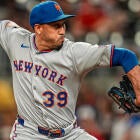
2017 Fantasy Baseball draft strategy: When searching for a potential ace, chase Robbie Ray's K's
In his continuing search for potential aces late in the draft, Chris Towers lands on Diamondbacks' pitcher Robbie Ray and his gaudy strikeout numbers.

Robbie Ray didn’t have a historic season in 2016, but what he did was pretty rare. By traditional measures of a pitcher’s quality, Ray had rough campaign, getting touched for a 4.90 ERA and 8-15 record for the Diamondbacks.
However, his advanced metrics paint a somewhat rosier picture, and this is where Ray stands out. In 2016, he posted a 3.76 FIP, giving him a 1.14 difference between his ERA and his FIP. That was the sixth-highest among all pitchers with at least 100 innings pitches in 2016, and the seventh-highest among all pitchers who qualified for the ERA title over the last 20 seasons.
At this point, it has been pretty well established that ERA isn’t the best predictor of a pitcher’s future performance. It just isn’t stable. A pitcher’s outcomes fluctuate wildly from year to year, but his skill set -- and the things he has more control over -- tend to be pretty static. Ray is a good example of this: In 2015, he posted a 3.52 ERA and 3.53 FIP, and while his FIP stayed pretty constant, his ERA jumped wildly.
So, it doesn’t take a leap of faith to say Ray will likely prevent runs at a better rate in 2017 than he did a year ago. That, of course, wouldn’t be enough to make him a potential ace. Even a 3.76 FIP, inarguably a solid mark, still placed just 41st among 144 pitchers with 100 innings pitches in 2016. However, there are some signs of a burgeoning star here, if you squint a bit.
Any discussion of Ray has to begin, of course, with his strikeout rate. Ray’s control is still mediocre, but he had the ninth-highest strikeout rate in baseball last season, as he set down 28.1 percent of opposing battings via the K. Lefties have never managed much success against Ray in his MLB career, and that shouldn’t come as much of a surprise because he sports a mid-to-high-90’s fastball and a wicked slider as his primary pitches. Lefties simply don’t have much hope against Ray, and he set down 31.9 percent of them on strikes last season.
However, dominating the small side of a platoon is never enough. Ray could be the best pitcher in baseball against lefties, but opposing managers knew to stack their lineups with righties. If Ray is going to take a big step forward, it will have to come against the bigger share of the platoon. And he showed some signs of doing just that in 2016.
Ray gave up a .272/.350/.447 slash line to right-handed batters last season, leading to an OPS more than .110 higher. However, when he was on, Ray was tough even for righties to handle. He struck out 26.9 percent of them in 2016, the third-highest mark in baseball. However, he also sported the fourth-highest walk rate among that group, negating at least some of the gains he made.
Strikeouts get headlines and rave reviews, but control might be the biggest thing Ray needs to improve from here on out. To oversimplify things, strikeouts might tell you how high a pitcher’s ceiling can be but walks can be the weight that keeps pitchers from getting there. Ray was in the 94th percentile among starters in strikeout rate last season and 15th percentile in walk rate, making him one of the most extreme examples in baseball.
Ray had other issues, of course, which is why he posted an ERA close to 5.00. Specifically, Ray couldn’t keep the ball in the yard, allowing 1.24 HR per nine innings. This may actually not be all that much of an issue moving forward, and this is one place where you can find even more reason for optimism. Despite his home run issues, Ray was about average in groundball rate, but gave up a 15.5 percent HR/FB rate, nearly double his 2015 rate. xFIP, a variant of FIP that attempts to normalize HR rate to account for some randomness, gives him a 3.45 mark, good for 17th in baseball.
Ray’s rate may not have been all the result of bad luck, of course, because he got hit hard all over the field. That resulted in a .352 batting average on balls in play, the second-highest among starting pitchers over the last 15 seasons. That is, obviously bad, and it isn’t all explained away by luck. However, as FanGraphs.com showed earlier in the offseason, only two pitchers have posted a BABIP over .330 in consecutive seasons over the last 15. Even if he doesn’t improve his skill much, Ray seems likely to come back to Earth. The question is, whether he can get it to a manageable enough place to live up to what some of the advanced metrics see in him.
Ray got hit hard last season, and his 36.6 percent hard-hit rate indicates opposing batters didn’t have much trouble making solid contact when they did get the bat on ball. However, he sported a 35.0 percent hard-hit rate in 2015, when his BABIP and HR/FB rate were much more manageable. Ray may always have trouble limiting hard contact, but things don’t have to be as bad as they were last season.
Ray is a flawed pitcher, and the fact that he plays half of his games in a park that inflates offense certainly doesn’t help. But if you’re chasing upside at starting pitcher -- as I am -- it’s hard to ignore Ray’s elite strikeout potential. As we saw in 2016, it is no proof that Ray’s results will be satisfactory, although he isn’t as far as his ERA might make you think.
With an ADP in the 19th round at FantasyPros.com, the upside is well worth the price.


















